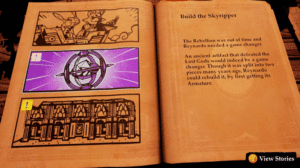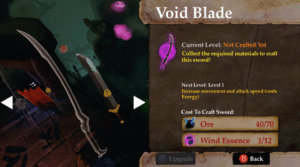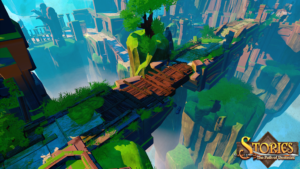Everyone makes decisions they come to regret. Even in video games like Mass Effect and Knights of the Old Republic, we often find ourselves wondering how our choices affected the outcome of the story we experienced. If we had chosen differently at a key moment, would it have made a difference? Usually, the only way to find out is to start over and play through another 40-60 hours of gameplay, which few people have the patience to do.
But what if you could experience all the branching paths in a narrative game without this barrier?
What if, instead, the game itself was structured in a way to bring you back through the key choices and allow you to see it all?
These questions underlie the design of Stories:The Path of Destinies, an action adventure game with a unique narrative structure. It is presented as a story book that acts as a mysterious, magical device that allows the main character to go back to a key moment in his journey over and over again each time he dies. You can then make different choices and see more of the world and its characters.
The content of the story centers around Reynardo, a retired sky pirate who, “Han Solo” style, is dragged into a rebellion against the Emperor. Reynardo needs to find some way to help the rebellion after they suffer an incredible defeat at Ubar. While this is an interesting story in its own right, it becomes fascinating when you are able to see it unfold in multiple different ways.
There are 24 different stories, which you discover by making different combinations of choices as you go. For example, the very first choice (and this isn’t really a spoiler because it is right at the beginning) asks you to choose between rescuing Reynardo’s friend Lapino or recovering a piece of an ancient, mysterious weapon. Both options lead to further choices that will ultimately lead you to one of the 24 different endings. The game only ends as you discover “truths” in the stories, which are snippets of information that are true in every permutation of the plot, that allow you to take new options that ultimately lead to the conclusion.
The game moves back and forth between the story book narration, where you make the key choices that shape the story, and segments of action adventure style gameplay. Of course, going through the story multiple times risks the action adventure segments becoming repetitive, but the developers have taken steps to prevent monotony. There is considerable character progression between stories. You keep all the progress you have made toward crafting new swords, all the items you have collected, and all the skills you have invested in with your experience points. The enemies become more varied and difficult with each story and the swords you craft allow you to take hidden paths through levels that you were not able to access before.
The combat sections of the game are quite enjoyable. Each encounter is fast-paced, and Reynardo controls quite well. He is a very mobile fighter, with abilities like a dash and a hook shot that brings enemies to him. As you gain more skills, you get even more options for dispatching enemies, and the swords you craft each have special abilities you can exploit, such as setting enemies on fire or healing Reynardo.
All of this action is accompanied with a striking presentation of Stories‘ world. The art style emphasizes the story book aesthetic: vibrant colors and almost a cell shading look with nice particle and lighting effects (this is a UE4 game, after all). The music and sound effects add the immersion, as they shift according to your choices in the game. If your choices are leading to a lighthearted narrative, the music reflects this direction, but it starts to sound a bit more sinister if you lead Reynardo down darker paths. The art and music direction show a lot of love and a desire to accentuate visually and aurally the narrative at the core of the experience.
And, of course, I could not end this review without highlight the narrator. Similar to Bastion, the narrator is always there, piping up all the time both to narrate the story and to comment on actions the player takes. The writing and performance of the narrator are spot on and a highlight of the game. His witty writing includes numerous pop culture and literary references as diverse as Galaxy Quest (yes, the 1999 Tim Allen and, more importantly Alan Rickman, movie) and Romeo and Juliet. This writing means that even the darkest stories have a fun sense of humor that fits this game well. Oh, and he does wonderful impressions of the characters as he speaks their dialogue, as I’m fairly certain the narrator is the only speaking role. It is a great voice performance that is a joy to hear.
I only have a few minor negatives to highlight for the game. Firstly, I thought that the final battle section got a bit repetitive. The reason for this is that the choices you make lead you to different areas along the way but they always end with the same final stage. You see this area, then, way more times than any other area in the game. Luckily, it does not take very long to clear this area, so it was not too much of a problem. Secondly, one particular choice leads to Reynardo dying, but instead of making that a “story” and giving me an ending, it set me, unexplained, back to the beginning of the previous level to play through it again before being presented with the same choices. This felt extremely out of place and was mildly irritating. Outside of this particular case, the game is quite generous with checkpoints, so having to complete the entire level again was a non-sequitur.
Lastly, and this is probably the most important negative, the title of the game is not very memorable. Stories: The Path of Destinies sounds very generic as a title. I told my wife I was playing this game and she assumed it was some throwaway game because the title seemed so generic (like Game of War: Fire Age and similar titles). Unfortunately, I think the title will be the key barrier to this game’s promotion, which is extremely unfortunate because it is so well-made. I think I would have tried to create a witty title in the same vein as the numerous referential jokes in the game, such as “A Fox in Time” or something similar.
All in all, Stories: The Path of Destinies is absolutely worth playing, both in the sense of providing a fun, meaningful experience and in the monetary sense–$15 is ludicrously generous for this game. It combines interesting, choice-based narrative with fast-paced, almost cinematic combat, all wrapped up with cohesive art and sound design that fit the stories perfectly.
Final Score: 92/100
See the game in action now by checking out my ongoing “Let’s Play” series:
PS for Parents: Despite the fun, animated look of this game, some parts may not be appropriate for young children. Some themes are decidedly adult in nature. Review the content yourself to decide if it is right for your children.





